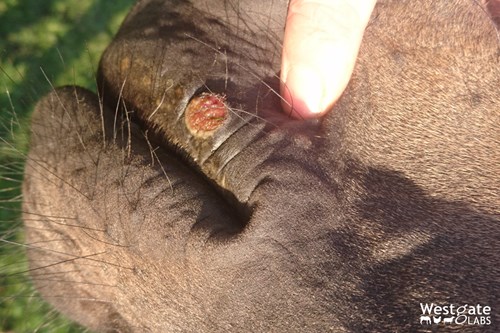Summer Sores in Horses Cutaneous Habronemiasis

Habronema Muscae, Habronema Microstoma and Drashia Megastoma are small usually harmless worms that live within the stomach of the horse. They rarely make headlines as infection seldom causes any clinical signs – that is until larval activity goes awry and summer sores or, more correctly, Cutaneous Habronemiasis or Draschia species infestation occurs.

Summer sores can affect all equines (horses, donkeys, mules and zebras) and they most commonly occur in places with a tropical or temperate climate. Here in the UK they’re quite unusual but certainly not unheard of to see.
Symptoms
Habronema or Drashia larvae cause a localised inflammatory reaction in the skin creating exuberant granulation tissue in a circular red, weeping sore. They can occur anywhere on the body of the horse but are most common on the lips and face, legs and any area of trauma to the skin.
Lifecycle
Like all intestinal parasites the adult worms shed eggs onto the pasture via the horse’s dung. The eggs hatch and if luck is in their favour they get ingested by the intermediate host that’s integral to the completion of the lifecycle – the maggots of the house and stable flies that are laid alongside them in the faeces.
The worm larvae develop inside the maggots as the maggots mature into adult flies. These gravitate back to the horse to feed off secretions of the nose, mouth, eyes, under the belly and any open wounds. When the timing is right the larvae aim to jump ship and get deposited around the mouth of the horse so that they can find their way back into the horse’s stomach to continue the lifecycle.
Summer sores occur when the larvae are deposited in other areas on the horse. They survive where there is moisture and fruitlessly try to burrow into the skin tissue, resulting in a raw, swollen lesion.
Diagnosis
Veterinary diagnosis is often made by debriding the wound to remove the degenerative larvae from the affected tissue – if summer sores are the cause then the parasite larvae appear like yellowish grains of rice within the wound. Habronemiasis can be confused with proud flesh, skin tumors such as sarcoids, carcinomas, fungal granulomas or other skin diseases.
If the lesion doesn't heal despite treatment then further biopsies may be needed.
Treatment
Summer sores are very unlikely to heal of their own accord without intervention. A single dose of Ivermectin is effective for both adult Habronema worms in the stomach and the larval forms in the skin tissue. In some cases steroids and antimicrobials may be prescribed alongside this by your vet to reduce inflammation and treat secondary infections - usually a result of self-inflicted biting, rubbing and itching. Good fly control goes hand in hand with the treatment and prevention of Cutaneous Habronemiasis disease. > more
The best and most accurate diagnosis is made with a biopsy. This is usually reserved for cases that do not respond to treatment.
Careful attention needs to be paid to unresponsive lesions or to fast growing lesions. If a lesion does not responds to therapy, if it is growing too fast or if it persists over the winter, it is important to consider further diagnostics.